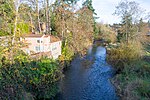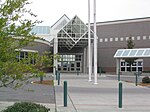Curtis Lake (Clark County, Washington)
Lakes of Clark County, WashingtonLakes of Washington (state)
Curtis Lake is a lake in Clark County in the U.S. state of Washington. The lake, near the confluence of Salmon Creek and Lake River, is northwest of the community of Felida.The lake is home to two nonindigenous aquatic species; Perca flavescens (yellow perch) and Pomoxis annularis (white crappie).
Excerpt from the Wikipedia article Curtis Lake (Clark County, Washington) (License: CC BY-SA 3.0, Authors).Curtis Lake (Clark County, Washington)
Northwest 57th Avenue,
Geographical coordinates (GPS) Address Nearby Places Show on map
Geographical coordinates (GPS)
| Latitude | Longitude |
|---|---|
| N 45.729166666667 ° | E -122.73861111111 ° |
Address
Robert L. Delanoy Airport
Northwest 57th Avenue
98685 , Felida
Washington, United States
Open on Google Maps










